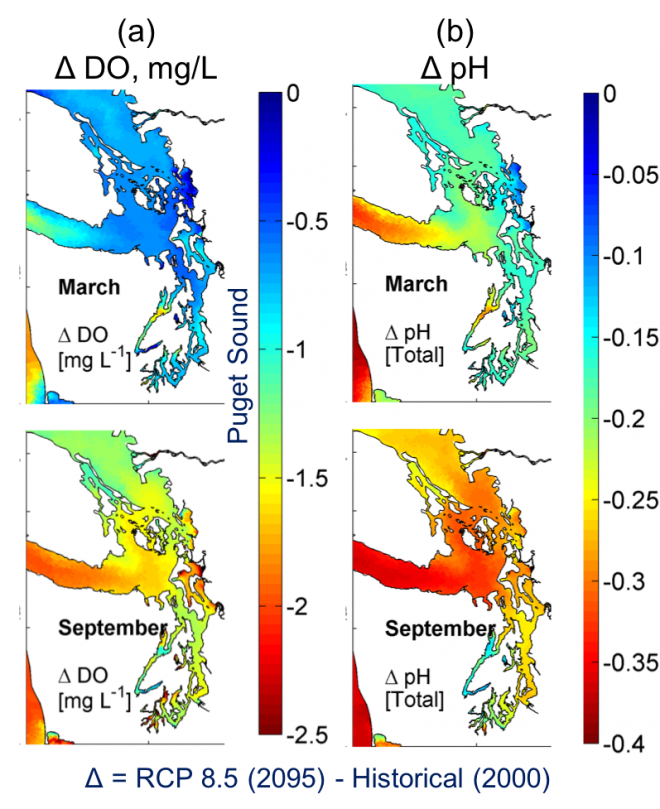Salish Sea Model looks at climate impacts on the nearshore
A 2019 paper in the Journal of Geophysical Research: Oceans outlines how the Salish Sea Model describes the impacts of climate change, sea level rise and nutrient loads on the region's nearshore environment.

Summary
While projections of global climate and its associated large‐scale impacts are well advanced, our understanding of the nearshore response is not as well developed. A better understanding of climate change impacts is needed in coastal estuarine regions, especially within the productive intertidal zones encompassing the terrestrial aquatic interface, tidal marshes, and the fish migration pathways. This was the primary concern expressed by our sponsors U.S. EPA and U.S. Army Corps of Engineers who jointly funded a study at Pacific Northwest National Laboratory (PNNL) to examine climate change impacts on our coastal waters. The study focused on parameters such as annual occurrences of hypoxia, algal blooms, and ocean acidification that are already of concern in the Pacific Northwest. We examined future response within Puget Sound, Washington (USA) and Georgia Basin, British Columbia (Canada) using the Salish Sea Model driven by down-scaled outputs from the National Center for Atmospheric Research climate model Community Earth System Model. A single projection of 95‐year change under the representative concentration pathway 8.5 greenhouse gas emissions scenario was simulated.

Results indicate that higher water temperatures, lower pH, and decreased dissolved oxygen levels in the upwelled shelf waters in the future would propagate into the Salish Sea. Results point to potential increases in average Salish Sea temperature (≈+1.51 °C), and decreasing dissolved oxygen (≈−0.77 mg/L) and pH (acidification −0.18 units) in the Year 2095 relative to historical Year 2000. The algal biomass in the Salish Sea could increase by ≈23% with a potential shift from communities dominated by diatoms to ones dominated by dinoflagellates. The region of annually recurring hypoxia could increase from <1% today to ≈16% in the future. The results suggest that the future response in the Salish Sea would be less severe relative to the change predicted near the continental shelf boundary. This resilience of the Salish Sea may be attributed to the existence of strong vertical circulation cells that provide mitigation and serve as a physical buffer, thus keeping waters cooler, more oxygenated, and less acidic. The PNNL paper titled “Salish Sea Response to Global Climate Change, Sea Level Rise, and Future Nutrient Loads” (Khangaonkar T, A Nugraha, W Xu, and K Balaguru, 2019) is one of the first to look at climate change projections for the Salish Sea region based on the Intergovernmental Panel on Climate Change (IPCC) fifth assessment effort.
Citation
Khangaonkar, T., Nugraha, A., Xu, W., & Balaguru, K. ( 2019). Salish Sea response to global climate change, sea level rise, and future nutrient loads. Journal of Geophysical Research: Oceans, 124. https://doi.org/10.1029/2018JC014670


